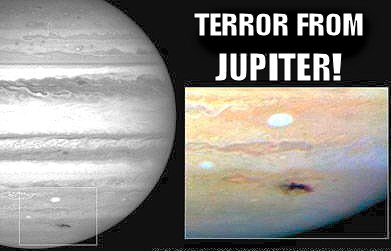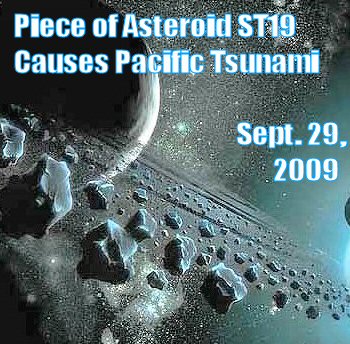 |
  |
 |
updated: April 30, "2010"
Past Impacts / Near Misses / Future Approaches |
|

What's New & Previews
Jimi's Prediction —
A Remote View About Jimi Hendrix Timeline Blog Asteroid Impact Evolution Woodstock Blues Jimi Code VS. Da Vinci Code Credit Thefts Missile Agency/Moon Base Charade Remote View Mutation Seattleland Censorship Events Skewed Science Search Engine Rankings Download An Ad AT&T: New Nuremberg Wall(y)flower Syndrome Rochester Media DVD/CD Store More Links... 
Page 8 of 8
May 2, 2006:
"A meteor smashed into the Moon's Sea of Clouds with 17 billion joules of kinetic energy-that's about the same as 4 tons of TNT," says Bill Cooke, the head of NASA's Meteoroid Environment Office in Huntsville, AL. "The impact created a bright fireball which we video-recorded using a 10-inch telescope." The video was recorded at the Marshall Space Flight Center.
NASA Video of Meteor Impact on Moon - May 2, 2006 (upper right)
June 7, 2006:
United Press International reports that at 2:05 a.m. a meteor impacts the country of Norway: "The meteor struck a mountainside in Reisadalen…residents of the northern part of Troms and the western areas of Finnmark could clearly see a ball of fire taking several seconds to travel across the sky. Knut Jorgen Roed Odegaard, the country's leading astronomer, said he expects the meteor to prove to be the largest to hit Norway in modern times…"We can compare it to the Hiroshima bomb," he said.
Following the Indian Ocean meteor that caused the Christmas Tsunami in Dec. 2004, news outlets were put under orders to conceal all news of space rocks. Mass media suppressed every mention of the 2006 Norway impact. Only through the websites of obscure European alternative papers are the facts available.
July 3, 2006:
In the early morning an asteroid a half mile wide named 2004 XP14 (check out the the "XP" connections on this website) nearly collided with Earth, coming about as close as the Moon. This passing was close enough to be visible to the naked eye in North America, so media could not conceal it and today the world is abuzz with news of the Rock. At the end of the ABC News report about XP14, the mass audience of network TV is introduced to Apophis for the first time.
ASTEROID NEAR MISS
MSM Introduces Apophis July 10, 2006:
European news media report that for the second month in a row, a meteor has crashed into the country of Norway. The rock smashed to the gound in the Jæren district just south of Stavanger in Rogaland County, gouging a crater just outside the house of Bjørn Herigstad.
Nov. 17, 2006:
Another meteor smashing into the moon is videotaped.
NASA Video of Meteor Impact on Moon - Nov. 17, 2006 (see left side near horizon)
September 16, 2007:
Meteor Crater In Peru 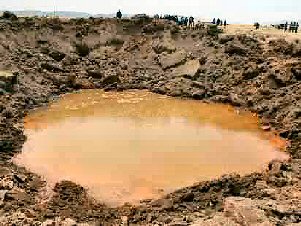 January 29, 2008:
"Largest Asteroid To Come Near Earth In 22 Years" is the headline at NewScientist.com. "The asteroid, named 2007 TU24, will make its closest approach on Tuesday (January 29, 2008), venturing as close as 1.4 times the distance to the Moon…Five hours of observations using NASA's Goldstone radio telescope in California, US, reveal that the asteroid is about 250 metres [several football fields] wide. The last time an object of about the same size was observed to approach Earth at about the same distance was in September 1985, says Don Yeomans, head of NASA's Near Earth Object programme at the Jet Propulsion Laboratory in Pasadena, California, US...Its discovery only a few months [October 11, 2007] before its closest approach to Earth highlights the importance of finding potentially dangerous space rocks." January 30, 2008:
Asteroid 2007 WD5 narrowly misses collision with Mars. The space rock was discovered in late November 2007 and is similar in size to an object that hit central Siberia 100 years ago in 1908. On January 4, 2008 NASA announced that asteroid 2007 WD5 will closely pass the Red Planet on January 30.
November 20, 2008:
Edmonton, Canada - Nov. 20, 2008
March 2, 2009:
On March 2, 2009 an asteroid came within 38 thousand miles of hitting Earth. Orbiting satellites are 20 thousand miles high.
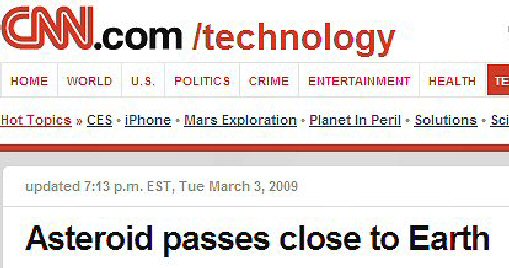 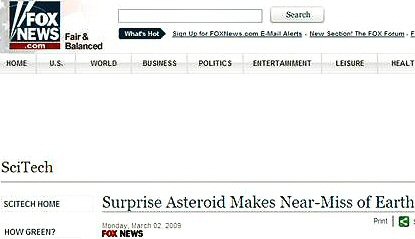 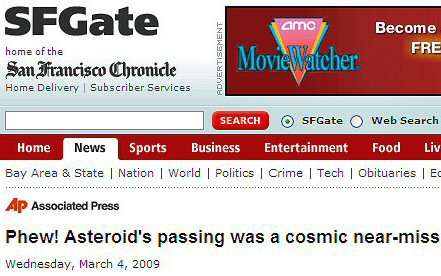  .
Two weeks after Asteroid 2009 DD45 nearly hit Earth, another space rock, 15 meters (49 ft.) wide, Asteroid 2009 FH comes within 79,000 kilometers (49,000 miles) of Earth on March 18, 2009. Another extremely close pass. Unlike the NEO pass two weeks ago, this time there is very little MSM reports about it, as if an artificial limit on "scary" news is being imposed by H.I.M.M.
March 18, 2009 Asteroid 2009 FH Near Miss 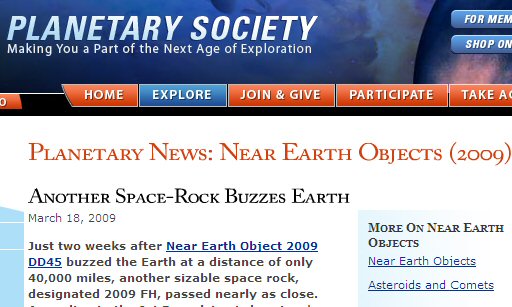 .
A "Triple System" Asteroid 
Asteroid 1994 CC comes within 1.56 million miles (2.52 million km) of Earth (about six times farther away than the Moon). The asteroid is composed of three separate rocks, known as a "triple system" - it is one of just two triple system asteroids known to be in a near-Earth orbit. Of all asteroids known to be "near-Earth" 15 percent are composed of two separate rocks. Just one percent are a triple system set up. The largest rock in the Asteroid 1994 CC system is about 2,300 feet (700 meters) wide. Two smaller rocks are revolving around the central object. .
Asteroid Smashing Saturn's Rings
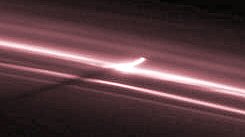
On August 9, 2009 an article titled "Like the Fist of an Angry God" at Discovermagazine.com reported, "The latest pictures [taken June 11, 2009] returned from the Cassini spacecraft (a probe the size of a school bus that has been orbiting the ringed planet since 2004)…is something new...[an] object on an inclined orbit has punched through Saturn's narrow F ring, bursting out from underneath, and dragging behind it a wake of particles from the rings. The upward-angled structure is definitely real, as witnessed by the shadow it's casting on the ring material to the lower left. And what's with the bright patch right where this object seems to have slammed in the rings? Did it shatter millions of icy particles, revealing their shinier interior material, making them brighter? Clearly, something awesome and amazing happened here. We are fated, I think, to watch Nature unfold before us and try to figure it out after the fact."
.
July 19, 2009 Comet/Asteroid Hits Jupiter -
exactly 15 yrs after last big impact there & on 40th anniversary of Apollo Moon Landing Jupiter Impact, Solar Eclipse, 40th Anniversary of Apollo Moon Landing
In the BBC video above, when Dr. Kaku describes Jupiter as the solar sytem's "vacuum cleaner" (at 1:29) and saves Earth from repeated asteroid impacts, that information is outdated and incorrect. Below is a link to current research which proves the opposite is true!
All In One Day!
More Video Reports About July 19, 2009 Jupiter Impact:
CNN w/discoverer Anthony Wesley 5:45
FOX NEWS with Bill Gates Hurricanes 1:40
ABC NEWS and KCAL 9 NEWS
On the anniversary of the impact over Peshtigo that killed 1200 Americans, an asteroid detonates above South Sulawesi, Indonesia, releasing as much energy as 50,000 tons of TNT, three times more powerful than the atomic bomb that levelled Hiroshima, making it one of the largest asteroid explosions ever observed. Energy from infrasound waves that rippled halfway around the world were recorded by an international network of instruments that listens for nuclear explosions. No telescope spotted the asteroid ahead of impact. October 16, 2009:
Asteroid 2009 TM8 flys by closer to Earth than the Moon. The 30-foot rock was spotted the day before by the Catalina Sky Survey in Arizona, demonstrating yet again that "early" detection of asteroids sneaking up on us is extremely unlikely. The one that hits will in all probability arrive unseen.
November 6, 2009:
Asteroid 2009 VA is spotted 15 hours before it passes just This is the third-closest known (non-impacting) Earth approach on record for a cataloged asteroid.
Jan. 13, 2010:
Asteroid 2010 AL30, 50 feet across, passed Earth within 80,000 miles (130,000 km) of our planet. That's nearly one-third the distance between the Earth the Moon, the closest near-Earth object approach currently known.
Jan. 14, 2010:
Asteroid 2010 AG30, 43 feet (13 meters) wide, passed Earth about 650,000 miles (1 million km) from Earth.
Feb. 10, 2010:
In the state of Hidalgo (central Mexico) a meteorite left a hole 30 meters in diameter and caused houses and buildings to shake in five municipalities of Hidalgo and Puebla.
April 8, 2010:
Asteroid 2010 GA6, 71 feet (22 meters) wide, passed within the orbit of the Moon, about 223,000 miles (359,000 km) from the Earth.
April 19, 2010:
Asteroid 2005 YU55 came within 1.5 million miles (2.4 million km) of Earth. That's about six times the distance between Earth and the Moon. The rock is about 1,300 feet (400 meters) in size - about a quarter-mile (400 meters) long and twice as big as originally thought.
April 20, 2010:
A New "PLAGUES OF EGYPT"
Galactic Debris Field Pelts Earth with Space Rocks 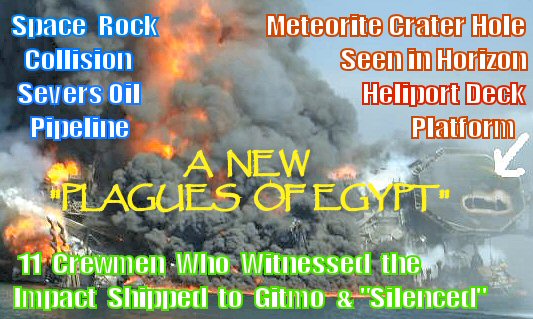 Media Fraudcast News Covers Up the Cause -
Moguls Deny It's All THE CURSE OF JIMI Avenging the Suppression of Rock Prophecy (I tol' ya'll yer gonna pay with yer planet, what'd ya think, this is some kinda joke?) . FUTURE APPROACHES: November 8, 2011:
Asteroid 2005 YU55 will approach Earth inside the Moon's orbit, at a distance of 191,120 miles (307,577 km) from our planet.
March 21, 2014:
Asteroid 2003 QQ47, called "an event meriting careful monitoring" by astronomers, rendezvous with Earth.
February 1, 2019:
Mile wide asteroid 2002 NT7 reaches Earth.
2022:
In February 2000 the University of Pisa issued a "scientifically urgent" warning about the trajectory of Asteroid 2000 BF19, aimed to arrive at Earth in 2022.
2024:
The 50-ft. asteroid known as 2007 XB23 will make one of the closest approaches to Earth.
August 7, 2027:
Asteroid 1999 AN10 will come within 800,000 kilometers (500,000 miles) of Earth, which is less than 3 times the Moon's distance from us.
October 26, 2028:
Mile wide asteroid 1997 FX11 is due to arrive.
April 13, 2029:
Asteroid 2004 MN4, a quarter-mile-wide Rock, is due to come within 22,600 miles of Earth, and be caught by Earth's gravity. In July 2005 NASA re-named this Rock "the Apophis."
September 21, 2030:
Asteroid 2000 SG344, a rock the size of an office building, arrives.
June 3, 2048:
Asteroid VK184 was discovered on November 12, 2007 by the Catalina Sky Survey. Thought to be about 430-foot in diameter (130 meters), NASA officials say it has a 1 in 2900 chance of hitting Earth on June 3, 2048.
February 1, 2060:
On July 29, 2002 the Associated Press reported, "Astronomers initially calculated at least seven potential impact dates [for 1.2 mile-wide asteroid 2002 NT7]...February 1, 2060 has yet to be ruled out."
2093:
NASA's Jet Propulsion Laboratory says asteroid 2002 EM7 could impact Earth.
2170:
On January 24, 2008 Steve Ostro, of the Near Earth Object program at the Jet Propulsion Laboratory in Pasadena, California, speaking about the near miss of Earth by asteroid 2007 TU24, said, "We can guarantee that there's zero chance of any [TU24] hazardous close approaches to Earth until 2170."
March 16, 2880:
Asteroid 1950 DA, two-thirds of a mile wide, arrives. Between now and the year 2880, 1950 DA will swing between Earth and Mars 25 times, each time it will be affected by the gravitational pull of Earth, coming closer with each pass.
"Earth-crossing asteroids larger than ten meters, there [are] over a hundred million of these objects in the sky...all of which are capable of colliding with the Earth." - Steve Ostro, Jet Propulsion Laboratory
"An asteroid about the size of a house comes between the orbit of the Earth and moon about once each day. An asteroid about the size of a football field comes between the Earth and moon about once each month."
- William Bottke, Fire In The Sky, TBS 3/23/97
"Recently declassified information has revealed some worrying statistics. On average our atmosphere is hit by an icy object from space, maybe 30 feet across, once a month. The information used to be secret, so similar were the impacts to high altitude explosions. Indeed, Earth-space is abuzz with debris. There are more chunks of asteroids and comets in our vicinity than scientists have ever suspected."
- Wonders of the Universe, TLC 5/95
"A decade-long study by the U.S. military revealed 250 detonations in the atmosphere over ten years. That averages 25 detonations a year, or one nuclear-type explosion every two weeks."
-Fire In The Sky, TBS 3/23/97
"I would suggest to those who think that we could survive the impact of a massive asteroid striking this country, need to think again."
- Oliver North, Prophecies of the Millennium, FOX 7/30/97
.
|
| © 2008 First Century Press. All Rights Reserved. Contact Us |

